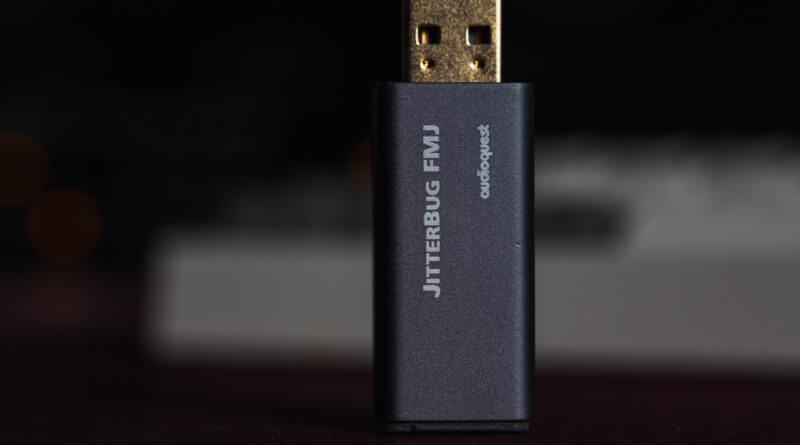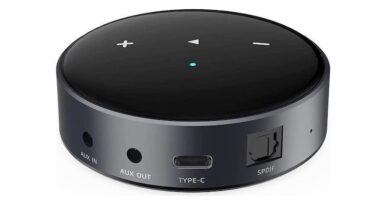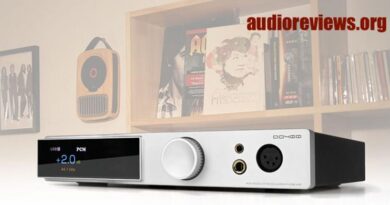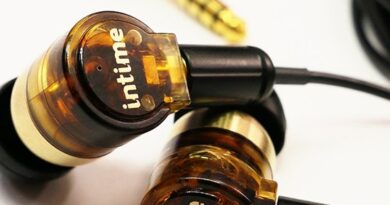AudioQuest JitterBug FMJ Review – It’s Not About Dancing…
Jitterbug FMJ is a recently released updated version of AudioQuest’s USB noise filter: JitterBug.
I have 3 units to test within my quite articulated home setup, and verify if / which sonic improvements are determined by the presence of one, or more, JitterBug FMJ units in line with and/or in parallel to my various DAC connections.
JitterBug FMJ retails in EU for € 69,00 and can be purchased from multiple sources, including Amazon. The manufacturer’s official information page is here.
In this Article
At-a-glance Card
| PROs | CONs |
| Significant sound quality improvement especially when plugged on gaming laptop and/or hosting dongle DACs | Does not “improve” on what is already perturbance-free |
| Fuller notes, darker background, better imaging | In my setup, no improvement on plugging second unit in parallel |
| Modestly priced |
Introduction
I know it very well: there’s a thick population of “non-believers” who apriori refuse the whole concept of USB filtering.
Sole thing I can say about and to them is: fair enough ! If you are one of that lot I recommend you stop here, don’t go forward reading this article as I guarantee you won’t like it so why bother.
Some others are instead very confused about the topic.
Not about AudioQuest’s JitterBug FMJ per se, actually, or not yet about it, insofar as they “stop much before”, not having clear which “noise” are we talking about that a device like JitterBug FMJ (and others, in the same category) is supposed to do something with.
To all of them I dedicated the introduction to a past article of mine reviewing IFI’s Nano iUSB 3.0 filtered power supply, which I spun off into a separate post some time ago precisely to conveniently back-link to it from within other review articles (like this one), without dumbly “re-pasting” the whole thing again and again.
Long story (too) short: there’s of course no way nor need to “improve” on digital data quality. There’s however point, and need, to avoid that data depletes during transport, and/or that transport media (cables) “trojan-ride” spurious signals, together with legit data, which may, and will, perturbate the DAC’s activity.
General description and features
JitterBug FMJ looks like, and has the size of, a common USB-key drive. It’s in facts a sort of “passthrough” thingie: on one end is a USB-A male plug, on the opposite end a USB-A female connector.
The chassis is metallic, studied to protect the inside from nearfield RF interference. The female USB port is protected by a removable “cap” make of rubber mixed with carbon – that, too, aiming at tackling RF interference. Both such features (metal chassis and backport cap) are indeed inherent to this new “FMJ” version and were not present in the original JitterBug. FMJ standing in facts for “Full Metal Jacket”.
Finally, the ciruitry on the PCB inside the case is aiming at removing in-line RF interference, such as that generated (or transmitted) by pretty much any digital device e.g. a computer, a TV, an audio player, etc.
You can see JitterBug FMJ as a filter reducing / eliminating any signal coming out of a USB port which is distant from the working frequencies required by the digital data which are solely supposed to be managed by that port.
As a consequence the DAC will receive “just what it’s supposed to get”, with no, or at least much less “other spurious stuff”.
Of course electrical impurities might not be there in the first place in some case, or, they may be filtered/rejected by some circuitry built into the DAC device itself, and in these cases adding a Jitterbug FMJ may be simply… useless.
Another case where a JitterBug FMJ may be only partially or not-at-all beneficial, is of course when spurious signals and interference are picked up downstream of its location.
So in general JitterBug FMJ (and all other similar equipment) is not – as it cannot be – a guaranteed hit, nor a guaranteed complete solution.
As in all or at least most things audio, a try is needed to know if and how much it benefits each particular setup.
How to use it (in the manufacturer’s intention)
Quite simply, Jitterbug FMJ is intended to be plugged into a USB port on a music player host (a pc, a mac or a linux box). Then, the USB cable leading to an external DAC or DAC/AMP will be plugged onto JitterBug FMJ’s female connector.
There’s no driver to install, no options to set. Just plug it in and leave it there.
The removable rubber cap covering JitterBug FMJ’s female port is supposed to be put back in place when no USB cable is connected. That’s because the carbon mixed into the rubber material helps acting as an anti-RF shield.
Always according to AudioQuest there’s also another way to use JitterBug FMJ: install 2 of them in parallel on the same host machine, plugging them onto two different USB ports (partaking to the same internal USB hub).
Onto one of the two JitterBug FMJ the USB cable going to the DAC is supposed to be plugged. The other JitterBug FMJ will just stay passively there, with the back rubber cap installed, and may (or may not) add a further level of intereference removal from the USB line.
OK, but does JitterBug FMJ actually work ?
Simply put: yes, and well, too.
First things first, I tried Jitterbug FMJ at its main intended usage scenario: plugged in-line between a host and a USB DAC or DAC-AMP.
I tried this on all 4 different hosts I normally use (also) for audio application, which are
- an aging MacBook Pro 2012 reourposed into acting exclusively as a Roon server
- a Lenovo Y520 laptop with Windows 10 which is my main general purpose work platform, including Roon Remoting, and gaming
- a BananaPi M2+ box with Debian Linux acting exclusively as a Roon Bridge, and
- a RaspberryPi 4 with Dietpi Linux (a well packaged Debian distro) also exclusively acting as a Roon bridge.
DACs (DAC/AMPs) connected to those include my Questyle CMA400i, the Earmen ST-AMP unit I’m reviewing, and the main “dongles” I own, which include Apogee Groove, E1DA’s PowerDAC 2.1, 9038D and 9038SG3, Questyle M15 and AudioQuest’s own DragonFly Cobalt. Oh, and a Chord Mojo, too, every now and then.
“Dongles” (i.e. host-powered) devices are by definition those exposed at the highest risk of “inheriting” host perturbance carried over via digital interconnects, that’s why I expect JitterBug FMJ’s effect to be most evident on them.
I also expect JitterBug FMJ to be more beneficial on devices plugged onto my Y520 laptop, and less so when the host is one of the raspberries (you should know the rationales of such expectation if you know this stuff at the technological level, or if you read my article referenced above).
Long story short: JitterBug FMJ does work, i.e. it did deliver a sound improvement, in all my different install positions.
The effect on final sound has been more evident, at times totally obvious, in some cases, and more subtle in others.
I can hear improvement on two main areas: better, more rounded up, fuller notes and darker background. Both these improvements together also result in a better sense of macrodynamics (imaging), which, depending on musical genre, also improves on rhythm perception.
Expectedly, out of all my gear the device for which the improvement is most subtle (yet still audible) is Questyle CMA-400i, no matter the host it is connected to.
Again very expectedly, the cases where Jitterbug FMJ’s improvement is obvious are those involving dongles (all of them – yes, including AudioQuest’s own Dragonfly Cobalt), connected to all my hosts, and maximally when connected to my Y520 “gaming” laptop.
Of course I also tried the other manufacturer-suggested use case, which is that of adding a second JitterBug FMJ in parallel to a first one, connected to a free USB port on the same host transport as the one onto which a USB DAC is connected.
This time my experience is not positive. Not negative either, actually, but I could not perceive any “further” improvement over the one obtained by the first unit – the one just plugged in-line between the host and the DAC. This happens on any one of my hosts, be them the small ARM SBC’s or the “noisy” gaming laptop.
Comparisons
iFi iSilencer+ (€ 59)
iSilencer is marketed as a device pursuing totally similar aims as JitterBug FMJ, so we can see it as iFi’s direct alternative to it. I had the opportunity to test a (few of) iSilencer unit(s), and I must say that, unlike Jitterbug FMJ, they did not hit the spot in my case.
Sadly, in my environment iSilencer wasn’t merely transparent (read: useless) but actually made sound worse: it fundamentally makes tones brighter, depressing mids and bass, reducing stage depth and making imaging worse.
iFi iPurifier 3 (€ 129/149)
iPurifier 3 is another device falling in the general “digital signal filters” category, but instead of removing carry-over electrical noise it focuses on signal timing – which is something on which JitterBug FMJ is only “consequently” involved.
I will soon release a piece about iPurifier3 but long story short: (in my setup) it does work. I’ve in particular been using it in-between one of my ARM-based Roon bridges and the Questyle CMA-400i desktop DAC-AMP, and it carried an audible improvement in terms of better treble notes definition, and perceivable better room size definition.
What’s even more interesting is that iPurifier 3 synergises positively with JitterBug FMJ: if I plug JitterBug FMJ on the ARM’s USB port, and iPurifier 3 on CMA-400i’s USB input port, I get both improvements at the same time. Very nice!
Conclusions
To me, JitterBug FMJ works – and very well so. It makes now standard part of my home setup, and I see no downsides to its adoption as an in-line USB channel filter, also considering its quite modest price tag.
A great thank you goes to AudioQuest for providing me with 2 more units (in addition to the one I earlier had already personally purchased) to allow me for extensive testing in multiple configurations.
Thanks a bunch to coblogger Kazi for the nice title image, too.
You’re too young!
JitterBug is the name of a Lindy Hop variation, that was common in the ’40ies. And yes – Lindy Hop is a dance style too.
For your own cultural improvement, here’s some correctly executed, if not greatly filmed, Jitterbug demo. Before you wonder: no – the dancing guy is not me 😉





